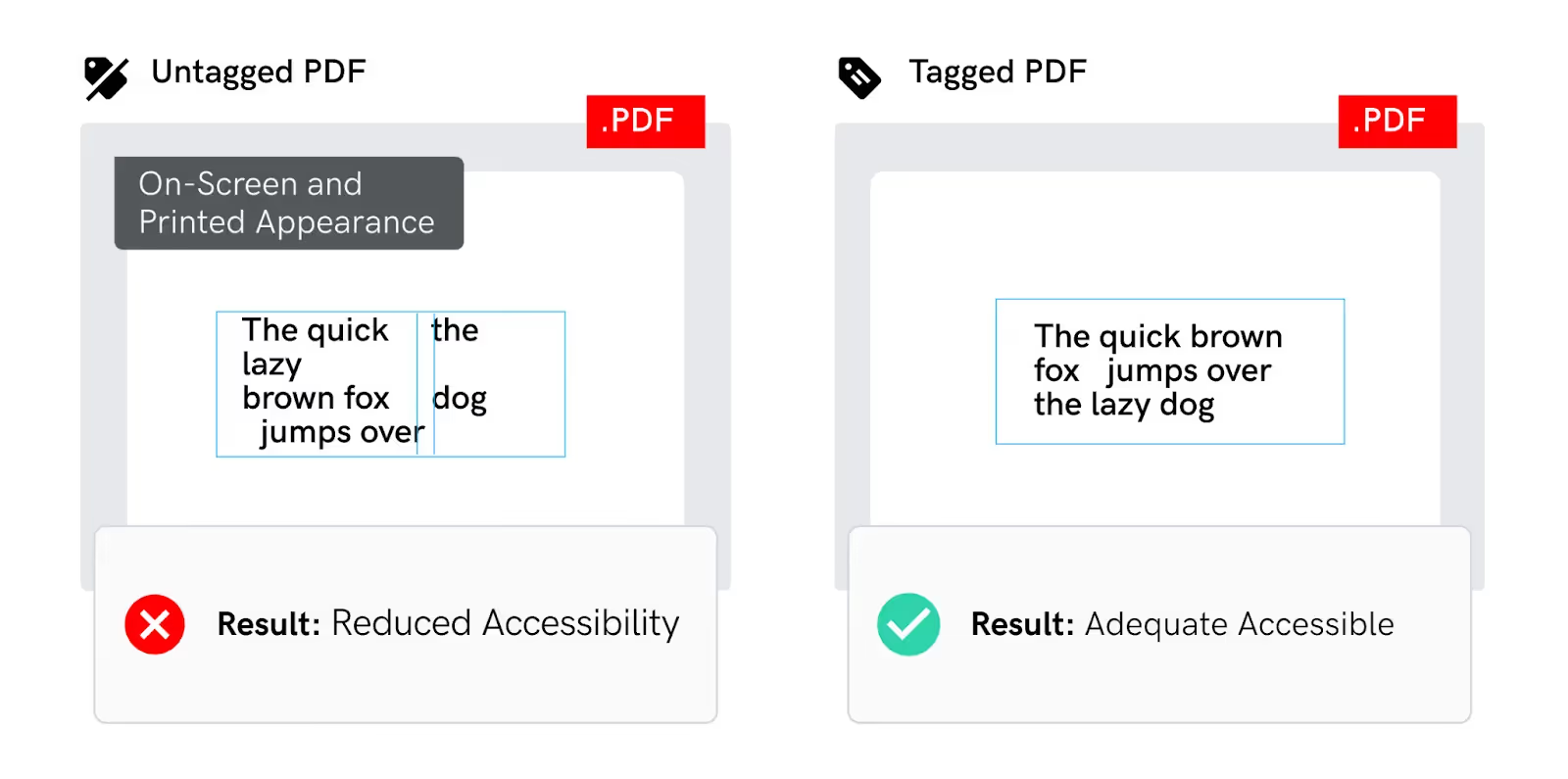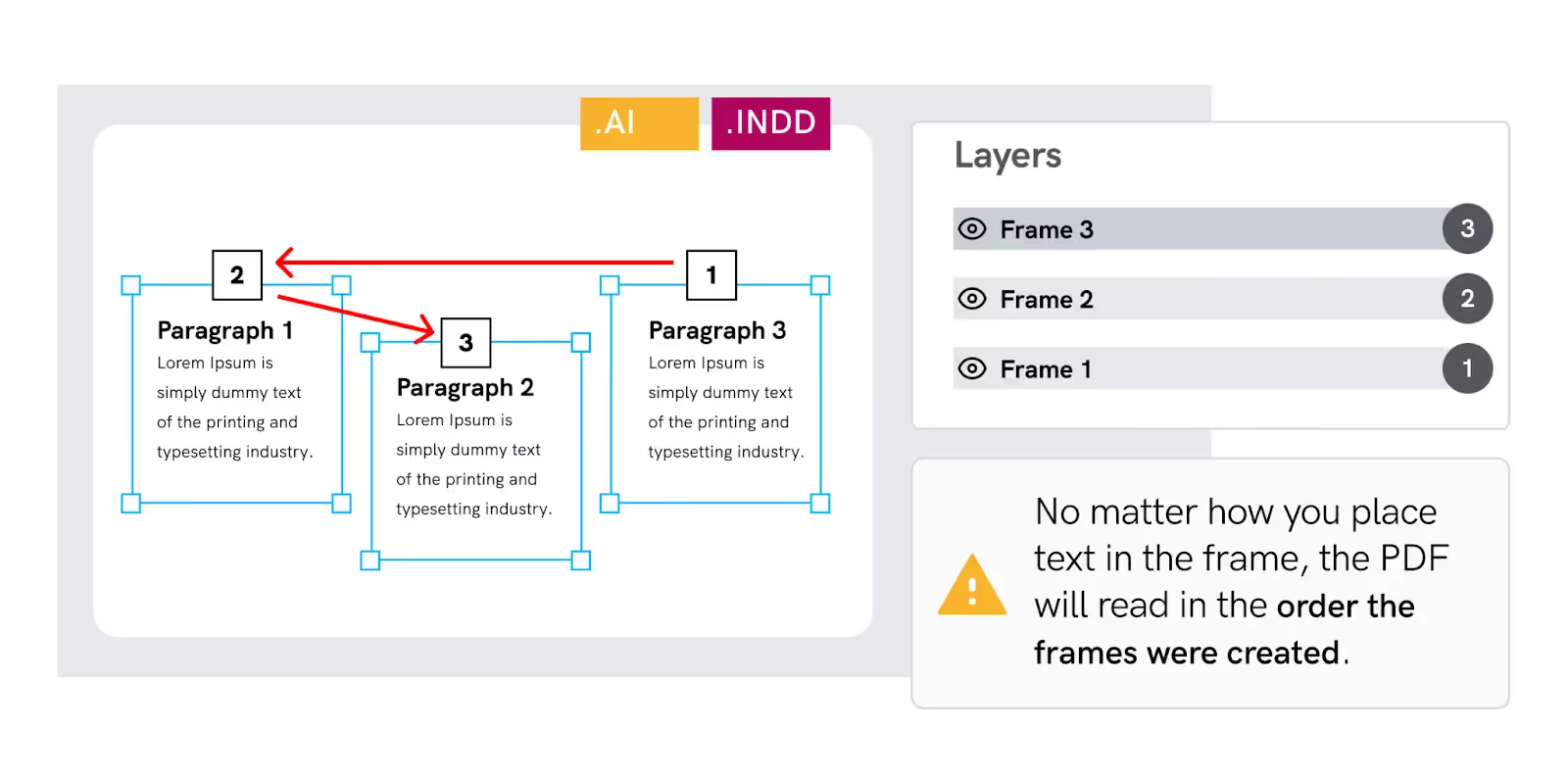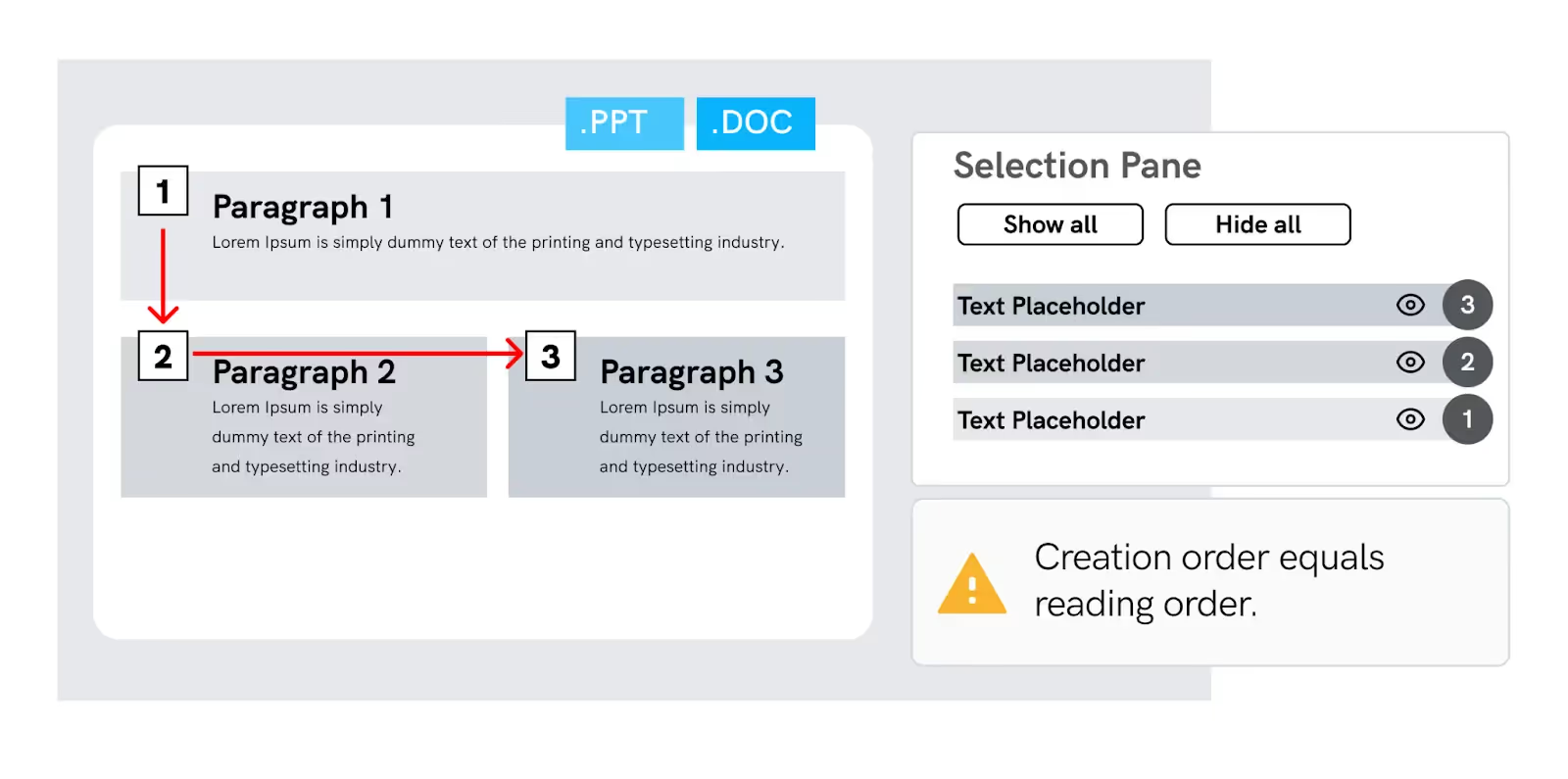Reading Order
Reading Order refers to the order in which the computer reads the file. It has nothing whatsoever to do with “logical order,” the sequence people use, which is defined in the PDF by tags. The following image represents an example of content as rendered on a PDF page:

Although it is simple, this example nonetheless demonstrates how reading order and logical order is distinct in a PDF file. In this example the reading order is as follows: <The quick the lazy brown fox dog. jumps over>. If the PDF is correctly tagged and the viewing software supports tags for content extraction and re-use, the text would appear in correct logical order and with appropriate semantics (in this case, a simple paragraph) as follows: <The quick brown fox jumps over the lazy dog.>
In this section, GlobalVision describes best practices when creating PDFs with correct reading order in mind.
Tagging PDF documents to structure a logical reading order
Risk
If you do not properly tag PDF documents, screen readers for the blind and other software packages or programs can misinterpret the PDFs content.
Issues
- PDF files do not naturally “know” the correct text order, which is undefined.
- Structured files are required to support applications where text order is
needed.
- Users who need assistive technology to read electronic documents require
structured PDFs.
Example

Solution
Do:
- Define the PDF’s content order in the Articles panel when using Adobe
InDesign.
- Ensure paragraphs, lists, heading, tables, and figures are properly tagged.
- Correctly Order Content, ensure that the tagged elements follow a logical reading order, matching the visual layout of the document.
- Choose an updated version of Adobe Acrobat
Don’t:
- Create a PDF without any tags.
- Disregard Logical Reading Order. Avoid creating a logical reading order that does not match the visual layout
Tips
Create tags to identify content elements as required and then use them to define text or page items with one of these techniques:
In Adobe InDesign:
- Open the "Structure" panel > Select text and images.
- Define their roles using the "Tagged" panel. For example, you can tag text as "H1" (Heading 1) or "P" (Paragraph).
- Export to PDF and choose a newer version of Adobe Acrobat.
- In the "Advanced" tab, make sure "Create Tagged PDF" is checked.
- Click "Export" to create the PDF.
Acrobat Pro:
- Go to the "Tools" menu.
- Select "Accessibility" and choose "Add Tags to Document."
Linking text frames (text boxes) to respect the reading order
Risk
If you do not link text frames, the internal reading order of the PDF may differ from visual text flow.
Issue
The reading order is compromised when linked text frames do not respect the same order in which they were created.
Example

Solution
Do:
- Add text in the same order in which the frames (text boxes) were created.
- Manage and/or change the reading order using layers and sublayers.
- Flow all text into the document, adding frames as necessary.
- Stack layers and/or sublayers from bottom to top to create the reading order.
NOTE: The order in which objects are created acts as the default reading
order.
Don’t:
- Create text frames and paste the text in a different order than the one in
which they were created.
- Ignore the layer order if you use text frames.
Tips
The following steps describe the semi-autoflow method, which lets the user flow
text from one frame to the next in Adobe InDesign and Illustrator:
- Hold down ALT (Microsoft Windows) or OPTION (Mac OS).
- Click the frame’s port icon, which appears as a “+” sign to show there’s additional overflow text.
- Create a new frame using the mouse cursor, which has now been “loaded” with the overflow text.
- The text will be pasted in automatically.
Managing the reading order in layers using Adobe InDesign and Illustrator
Risk
If you do not manage the reading orders in your layers, screen readers may misinterpret a PDF due to unstructured content.
Issue
The PDF file’s text order is undefined, with structured files needed to support
applications requiring just the opposite.
Example

Solution
Do:
- Use stacked layers and/or sublayers from bottom to top to establish the reading order.
- Establish the reading order of items in the Adobe InDesign file before
converting it into a PDF.
- Create a tagged PDF in Adobe InDesign.
NOTE: The order in which objects are created acts as the default reading
order.
Don’t:
- Create text frames and paste the text in a different order than the one in
which they were created.
- Ignore the layer order if you use text frames.
- Tag a PDF in Adobe Acrobat Pro using the “Add tags to document“ function if
you’re using layers (z-order).
Tips
The following steps describe how to adjust the stacking order in Adobe InDesign
and Adobe Illustrator:
- Select the object or text frame by clicking on it once with the Selection tool.
- Change the stacking order of the objects within the layer as desired by dragging the little square (located in the upper-right corner of the group).
Managing the reading order in Microsoft Word and PowerPoint
Risk
If you do not manage the reading order in your Microsoft Word or PowerPoint files, the internal reading order of a document may differ from the visual text flow.
Issue
When stacked objects do not respect the logical reading order of a Microsoft
Word document, the reading order is compromised.
Example

Solution
Do:
- Stack layers and/or sublayers from the bottom to the top to create the reading order.
- Avoid using text boxes and floating objects.
- Use Microsoft Word’s paragraph spacing settings.
Don’t:
- Create text in a different order than what is logical to read.
- Use carriage returns, tabs, and other blank characters to create white space
in a document.
- Use blank cells for formatting in tables.
Tips
The following steps describe how to adjust the stacking order in Microsoft Word:
- Right-click the object (or grouped objects) that you want to bring to the front, or send to the back.
- Click “Bring to Front” or “Send to Back” in the options menu that pops up.


